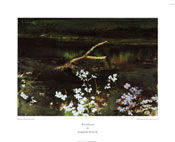
Wishbone
‘Wishbone’ by Andrew Wyeth
A wishbone is a lucky charm, and lucky we are that Andrew Wyeth came across a tree branch resembling one, and decided to share his vision in a painting entitled ‘Wishbone’. The scene’s focus is placed on a lonely forked branch that rises like an arm struggling to stay afloat while being pulled by the river’s current. It aptly resonates Andrew Wyeth’s words, “Nature is not lyrical and nice; behind the peace is violence”.
‘Wishbone’ is a beautiful composition that discloses a powerful contrast between a narrow, restful river bank in the background and a wide ribbon of rushing water in the foreground. Although the river appears fast-moving, Andrew Wyeth introduced some calm by adding patches of dainty pastel flowers. The painting displays the vivid and lush greens that are associated with summers in Cushing, Maine, where he spent much time applying his skill to canvas.